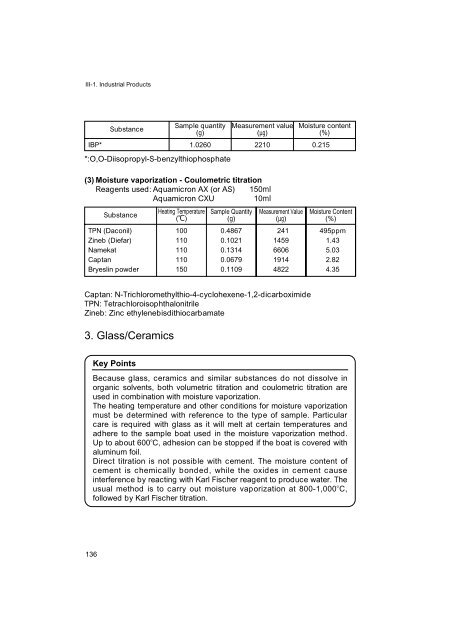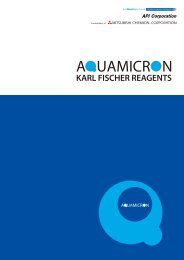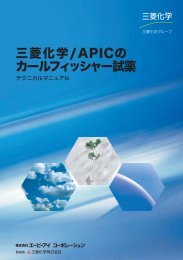Development of Karl Fischer Reagents
Development of Karl Fischer Reagents
Development of Karl Fischer Reagents
Create successful ePaper yourself
Turn your PDF publications into a flip-book with our unique Google optimized e-Paper software.
III-1. Industrial Products<br />
136<br />
Substance<br />
Sample quantity<br />
(g)<br />
Measurement value<br />
(µg)<br />
Moisture content<br />
(%)<br />
IBP* 1.0260 2210 0.215<br />
*:O,O-Diisopropyl-S-benzylthiophosphate<br />
(3) Moisture vaporization - Coulometric titration<br />
<strong>Reagents</strong> used: Aquamicron AX (or AS) 150ml<br />
Aquamicron CXU 10ml<br />
Substance<br />
TPN (Daconil)<br />
Zineb (Diefar)<br />
Namekat<br />
Captan<br />
Bryeslin powder<br />
Heating Temperature<br />
( � C)<br />
100<br />
110<br />
110<br />
110<br />
150<br />
Sample Quantity<br />
(g)<br />
0.4867<br />
0.1021<br />
0.1314<br />
0.0679<br />
0.1109<br />
Measurement Value<br />
(µg)<br />
0241<br />
1459<br />
6606<br />
1914<br />
4822<br />
Captan: N-Trichloromethylthio-4-cyclohexene-1,2-dicarboximide<br />
TPN: Tetrachloroisophthalonitrile<br />
Zineb: Zinc ethylenebisdithiocarbamate<br />
3. Glass/Ceramics<br />
Key Points<br />
Moisture Content<br />
(%)<br />
495ppm<br />
1.43<br />
5.03<br />
2.82<br />
4.35<br />
Because glass, ceramics and similar substances do not dissolve in<br />
organic solvents, both volumetric titration and coulometric titration are<br />
used in combination with moisture vaporization.<br />
The heating temperature and other conditions for moisture vaporization<br />
must be determined with reference to the type <strong>of</strong> sample. Particular<br />
care is required with glass as it will melt at certain temperatures and<br />
adhere to the sample boat used in the moisture vaporization method.<br />
Up to about 600 � C, adhesion can be stopped if the boat is covered with<br />
aluminum foil.<br />
Direct titration is not possible with cement. The moisture content <strong>of</strong><br />
cement is chemically bonded, while the oxides in cement cause<br />
interference by reacting with <strong>Karl</strong> <strong>Fischer</strong> reagent to produce water. The<br />
usual method is to carry out moisture vaporization at 800-1,000 � C,<br />
followed by <strong>Karl</strong> <strong>Fischer</strong> titration.




